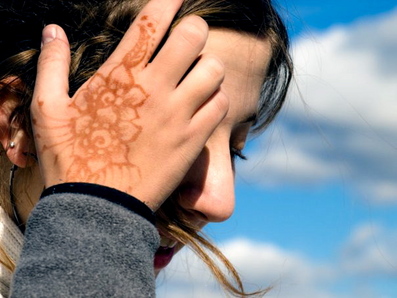Henna Care
Why does the henna look green? I thought it was supposed to be red! Is this mud or something?
Henna powder is the ground dried leaves of the henna plant, which is naturally green. To apply henna, the powder is mixed into a paste, which is usually a greenish-brownish colour. The paste is applied and left to dry on the skin; during this time, the dye molecules from the henna paste are moving into the skin (the uppermost layer of dead skin, called the stratum corneum) and binding to it. The longer you leave the paste on, the darker and longer-lasting the stain. I recommend a minimum of an hour or two. After the dried henna is removed, the stain will appear bright orange.
Over 48 hours, it should slowly darken to a reddish-brown. Depending on where the henna is and your personal skin type, the colour may vary from a light brown to a dark chocolate colour. Henna is NEVER black (see FAQs).
Henna powder is the ground dried leaves of the henna plant, which is naturally green. To apply henna, the powder is mixed into a paste, which is usually a greenish-brownish colour. The paste is applied and left to dry on the skin; during this time, the dye molecules from the henna paste are moving into the skin (the uppermost layer of dead skin, called the stratum corneum) and binding to it. The longer you leave the paste on, the darker and longer-lasting the stain. I recommend a minimum of an hour or two. After the dried henna is removed, the stain will appear bright orange.
Over 48 hours, it should slowly darken to a reddish-brown. Depending on where the henna is and your personal skin type, the colour may vary from a light brown to a dark chocolate colour. Henna is NEVER black (see FAQs).
Scroll through the photos below to see the different stages of a henna stain!
How long does henna last?
The stain should last for a couple of days at the very least, and may last as long as a month. Thinner skin (i.e. the back, stomach, inner arm) will fade faster than thicker skin (palms and soles). Also, the faster you exfoliate, the faster your mehndi will fade. Dabbing the dried henna paste with a sticky syrup (usually a lemon juice/sugar mixture) before you remove it will make it last longer, as will keeping the henna on overnight (wrap it up to avoid crumbs in your bed!). Henna stains are extremely variable and depend a lot on skin chemistry. If you get a particularly poor stain or it fades unusually fast, try another one on a different body part!
Caring for my henna
Once the paste is on, make sure to be careful not to smudge it; mistakes can’t always be repaired and they may stain. Nobody wants to end up with a brown splotch on their hand. Leave the henna on for as long as possible; an hour at the very least, and if the henna is on the upper arm, chest, stomach, or back, several hours at least are preferable. Once you’re ready to remove the paste, rub it off over a garbage can. You can use a little oil to get off the hard-to-remove bits. Don't wash it off, and try and avoid washing the area for at least 24 hours. Moisturizing often will help preserve the stain.
There is a tradition that once a person has henna, they can’t do housework or chores until the henna fades! Enjoy!
The stain should last for a couple of days at the very least, and may last as long as a month. Thinner skin (i.e. the back, stomach, inner arm) will fade faster than thicker skin (palms and soles). Also, the faster you exfoliate, the faster your mehndi will fade. Dabbing the dried henna paste with a sticky syrup (usually a lemon juice/sugar mixture) before you remove it will make it last longer, as will keeping the henna on overnight (wrap it up to avoid crumbs in your bed!). Henna stains are extremely variable and depend a lot on skin chemistry. If you get a particularly poor stain or it fades unusually fast, try another one on a different body part!
Caring for my henna
Once the paste is on, make sure to be careful not to smudge it; mistakes can’t always be repaired and they may stain. Nobody wants to end up with a brown splotch on their hand. Leave the henna on for as long as possible; an hour at the very least, and if the henna is on the upper arm, chest, stomach, or back, several hours at least are preferable. Once you’re ready to remove the paste, rub it off over a garbage can. You can use a little oil to get off the hard-to-remove bits. Don't wash it off, and try and avoid washing the area for at least 24 hours. Moisturizing often will help preserve the stain.
There is a tradition that once a person has henna, they can’t do housework or chores until the henna fades! Enjoy!
